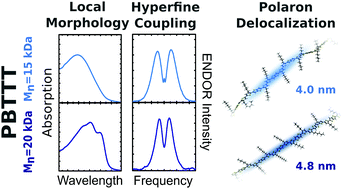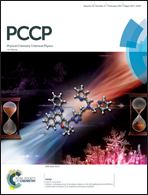Impact of morphology on polaron delocalization in a semicrystalline conjugated polymer†
Abstract
We investigate the delocalization of holes in the semicrystalline conjugated polymer poly(2,5-bis(3-alkylthiophene-2-yl)thieno[3,2-b]thiophene) (PBTTT) by directly measuring the hyperfine coupling between photogenerated polarons and bound nuclear spins using electron nuclear double resonance spectroscopy. An extrapolation of the corresponding oligomer spectra reveals that charges tend to delocalize over 4.0–4.8 nm with delocalization strongly dependent on molecular order and crystallinity of the PBTTT polymer thin films. Density functional theory calculations of hyperfine couplings confirm that long-range corrected functionals appropriately describe the change in coupling strength with increasing oligomer size and agree well with the experimentally measured polymer limit. Our discussion presents general guidelines illustrating the various pitfalls and opportunities when deducing polaron localization lengths from hyperfine coupling spectra of conjugated polymers.



 Please wait while we load your content...
Please wait while we load your content...